

“This is not a disease that can be solved by one person. It needs a community, and lots of expertise. I will work with anybody to do this.” Ron Davis
The Working Group was impressive. Davis had Bob Naviaux to his left and Maureen Hanson next to him and Nobel Prize winner Mario Capecchi to his right and Ron Tompkins next to him. Seated down the way (so that he could hear better) was Nobel Prize winner Paul Berg.
The Working Group sessions were designed to keep the participants talking. Breakfast, lunch and dinner were provided to keep the researchers communicating. Ample breaks and discussion periods were the theme of the day. It was all about communicating.
The few of us non-researchers in the room (Janet Dafoe, Mary Dimmick, Ashley Davis, Linda Tannenbaum and I) were seated so as not to disturb. During the Working Group sessions we were seated along the wall and we had our own table at dinner. The emphasis on getting the researchers talking with one another worked as they gabbed away during the numerous breaks. (Janet Dafoe said members of Ron Davis’ Stanford Group were buzzing with new ideas at their meeting the next week.)
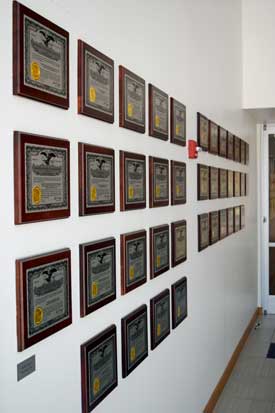
Ron Davis has been very productive but his biggest challenge probably lies before him. Here’s one of the patent walls at his Stanford Genome Center.
Researchers and leaders from around the area showed up for the Symposium. Carol Head and Zaher Nahle from Los Angeles, Dr. De Meirleir, Annette Whittemore and Vincent Lombardi from Reno, Nevada and Dr. Peterson from Incline Village all showed up. The Working Group came from Scandanavia, Australia, the East Coast and other locales. The odd man out was Dr. Montoya, who, just a couple of buildings away, was not present.
It’s always humbling being in the presence of researchers talking about their research. The vast majority of conversation went right over my head.
The Working Sessions and the Symposium
“It takes a village to solve a disease and you’ve created a really great village.” Bob Naviaux to Janet Dafoe during the Working Group sessions.
Ron Davis
Ron Davis started off the session in typical Ron Davis fashion stating that because we really don’t know where to look, we’re looking in as many places as we can.
Davis is very focused on cellular energy production, but is keeping his options open. He’s apparently seen too many sure things go by the wayside to do anything but that. The first step is to look everywhere.
Davis went over the “nano-needle” his lab has produced and its finding of increased cell impedance when ME/CFS cells are put under stress. Those high impedance levels suggest that ME/CFS patients’ cells are unable to meet their energy demands when put under stress.
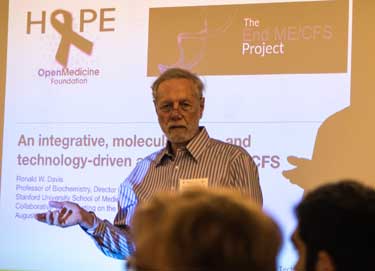
Davis has began filtering substances out of ME/CFS patients’ plasma in an attempt to isolate the offending factor. (Note that the problem could also be a missing factor – something missing in ME/CFS patients’ blood.) The first stab indicated that the substance or compound was likely a large molecule; the next that it may be an antibody or something attached to an antibody. That’s an intriguing finding given Mark Davis’ belief that ME/CFS is probably an autoimmune disease.
Severe Patient Big Data Project Findings
Thus far the massive project has identified 14 genes that are possibly implicated in ME/CFS, including one highly suspect gene that had damaging mutations in every severe patient but not in a single healthy control.
Davis, as usual, expressed caution; that gene – which affects serotonin processing and regulatory T-cells – could be associated with severity but may not be causing ME/CFS; i.e. ME/CFS might simply be worse in people with these mutations. Either way, if the finding holds up, it’s a clue – an arrow pointing at an area of dysfunction.

Fourteen genes have popped out and aberrations of one gene have been found in every severely ill patient.
Problems with that gene could conceivably make it difficult to halt the proliferation of T-cells – ultimately putting ME/CFS patients at risk for an autoimmune disease.
Davis also clicked through a number of dead ends: cell free DNA, viruses, new pathogens, mitochondrial DNA concentrations – all of these have been normal in the severe ME/CFS patients. Some of the tests Davis included in the Severe Patient Big Data study he thought unlikely to find answers. So why include them? Because Davis is doing his due diligence – he’s searching everywhere and he’s not rejecting anything without getting data on it.
OMIC’s studies like the Severe Patient Big Data study and the Snyder study (see below) are big, expensive, complex projects but Davis said the genome project and others have shown that they’re actually quite cost-effective. (Certainly more cost-effective than a series of smaller, poorly integrated studies that sniff around the edges of a disease).
Davis’ Working Group talk sparked a lot of interest. Chris Armstrong asked if those stressed ME/CFS cells happened to be swelling. Davis didn’t know but emphasized that they did not appear to be dying. Bob Naviaux suggested adding glucose and using a glucometer to assess glucose levels in the plasma.
The nano-needle test is fast and cheap, but much more work is needed before it can be considered a diagnostic test for chronic fatigue syndrome (ME/CFS).
Wenzhong Xiao
Wenzhong Xiao is the man putting all the many different parts of the Severe ME/CFS Data Project together. Ron Davis called him a “force”. Creative disrupter might be another good way to describe him, as Xiao’s had this rather irritating (to some) tendency to point out flaws in several major programs. In short, he’s just the kind of person Davis appreciates.
Xiao hails from Harvard and Mass. General Hospital, but worked in Davis’ lab before. He started off by noting the stunningly low quality of life findings in ME/CFS compared to other severe diseases. The Fitbit tracking from the study is bearing that out; the average severely ill patient in the study takes about 1,000 steps a day – about 10 times less than the average healthy control in the study (@ 10,000).
Metabolites, of course, have been a primary focus of Davis and the Open Medicine Foundation. Davis described doing test after test after test on Whitney and getting some abnormal results, but nothing particularly exciting until Whitney’s metabolite test results showed massive differences. In some cases, Whitney’s metabolite levels differed from those of healthy controls by a factor of 10-100.
Metabolites appear to be showing up strongly in the severe ME/CFS patient cohort as well; Xiao reported that he’s finding a large difference in about half the metabolites he’s measuring in the severe patients compared to the healthy controls.
Immune findings are showing up strongly as well; a third of the cytokines tested (21) – in the largest array of cytokines tested yet (n=61) – were different between severe ME/CFS patients and healthy controls. That, mind you, is at baseline and unlike the Montoya/Mark Davis study, the Severe ME/CFS study didn’t need to take severity into account to get significant differences. That suggests far larger cytokine differences are present in the very severe patients vs less severe patients.
The Gist
- Early results may have pinpointed one specific gene aberration in severely ill ME/CFS patients.
- Metabolites, immune and gut studies are finding significant differences in severely ill ME/CFS patients.
- Gene expression results suggest ME/CFS is most like Systemic Inflammatory Response Syndrome (SIRS) – disorder similar to sepsis.
- The Mike Snyder team has embarked on a large “omics” study which includes 20 families and hundreds of patients and pluripotent stem cell production.
- Gene data from the study suggests problems with immune functioning and metabolism are present.
- High rates of T-clonal cell expansion suggest that ME/CFS patients’ T-cell are reacting to a pathogen, toxin or some other factor.
- If Mark Davis can determine what those cells are reacting to, he may be able to uncover what’s going in the immune system in ME/CFS.
- Maureen Hanson’s study suggests that ME/CFS patient’s’ immune cells may not have the energy to become fully active.
- Hanson’s metabolomics study found low glucose and similar findings to Bob Naviaux’s earlier metabolomics study.
- Thus far, Jarred Younger’s Good-Day / Bad-Day Study is finding three subsets – a subset characterized by inflammation (c-reactive protein), by a substance called fraktalkine, and an uncharacterized subset.
- Jonas Bergquist is finding auto-antibodies to the receptors that open and close the blood vessels in ME/CFS patients. He is in the midst of a metabolomics and cerebral spinal fluid study as well.
- Bob Naviaux’s small trial of Suriman was successful in autism. He hopes to try the drug in ME/CFS.
In one of the most exciting moments of his 2014 Stanford Symposium, Dr. Montoya stated that ME/CFS most looked like Systemic Inflammatory Response Syndrome (SIRS). That was it for SIRS and ME/CFS for several years, but here was Xiao reporting that his gene expression data suggests that ME/CFS looks more like SIRS than any other disease as well. SIRS, it turns out, refers to body-wide inflammation. It’s characterized by lowered body temperature, increased heart rate, rapid breathing and low white blood cell counts – all of which have been found at times in ME/CFS.
The microbiota study is showing significant differences in the gut flora with three bacteria showing up in particular in ME/CFS patients. NK cell gene expression is significantly down-regulated in ME/CFS as well.
A Hypothesis Generating Machine
I asked Xiao later about the Severe ME/CFS project. The goal of the project is simple – to gather enough data in as many areas as possible in order to generate hypotheses – ideas about what’s happening in ME/CFS – that can be tested.
When I asked him about the difficulty of somehow putting those millions of data points together, I was surprised to learn that that’s not an issue for him. Some of the techniques to do this kind of thing, he said, were created by companies like Google and Amazon.com with far larger data streams.
The big issue is filtering out the wheat from the chaff. Xiao is going to find lots of associations, but he and others at the workshop are focused on getting at the cause, and that’s a different and more difficult thing. (Separating the wheat from the chaff and how to do that was a common theme in the workshop.) If I got it right, Xiao’s putting the Severe ME/CFS data into a database which has research findings incorporated into it; this, in turn, helps him interpret the data.
In the end we could get something like a metabolic breakdown resulting in aberrant immune activity which is causing the symptoms.
In order to get as many minds as possible working on ME/CFS, Ron Davis has promised to open up his data and that’s going to happen. Raeka reported that a web-based data platform for analysis and visualization of these datasets is going to be rolled out soon.
Chris Armstrong – an active participant in the Working Group session – suggested that problems with glycolysis could be inhibiting cytokine production. That’s a fascinating suggestion given the findings of low cytokine levels in the longer duration patients in Lipkin/Hornig cytokine study. It suggests that energy production problems are behind the immune problems in ME/CFS.
We’ll see suggestions later that energy issues could: a) be keeping immune cells from getting activated, or b) be setting the stage for autoimmunity. It takes massive amounts of energy for an immune cell like a monocyte to turn into a pathogen killing macrophage. We should learn more about the energy/immune connection in ME/CFS from several studies the Solve ME/CFS Initiative is funding.
Nobody has looked at severe ME/CFS patients (or any other kind of ME/CFS patients) with this kind of detail before. A central question is whether the severely ill will provide answers to what’s going on with less severely ill patients or if they’re atypical in some ways. A Simmaron Research Foundation study found distinctly different spinal fluid signatures in the atypical (more severely ill, often unusual disease onsets, increased comorbidities) vs the more typical patients. Once the results are in the OMF’s database, the next step will be determining if they’re found in less severe patients.
At the very least, we’re going to learn a lot about the most severely ill ME/CFS patients. Potentially, we’re going to get clues to what’s happening in everyone. It’s going to be fascinating.
Mike Snyder
“When you don’t know what the solution is…try everything” Mike Snyder
Snyder’s a big deal in the genomics world.
The Chair of the Genetics Dept. at Stanford, with a jaw-droppingly large laboratory, Snyder’s kind of a rock star in the field of genomics. Considered a pioneer in bringing “big data” to real-life results, Snyder’s lab has many “firsts” to its name; the first to do a functional genomics project, the first to develop proteome chips, the first to develop high resolution tiling arrays for the entire genome, the first to do “paired-end sequencing”, etc.
Snyder’s lab determined that junk and other parts of the genome previously thought to be useless are actually quite active. Snyder’s also cofounded several biotechnology companies (Protometrix (now part of Life Technologies), Affomix (now Illumina), Excelix and Personalis). He’s also on the cutting edge of the wearables revolution that many people think is going to transform medicine. Snyder, himself, used his increased heart rate and altered oxygen wearable readings to get to a doctor after a trip. The doctor found he’d contacted Lyme disease on a vacation in the Northeast, and a potentially very serious illness was nipped in the bud.
Snyder’s so big on the possibilities of personalized medicine – something he’d love to see in ME/CFS – that he wrote a book on it.
Despite having family obligations, he somehow managed to attend most of the Working Group sessions and Symposium. Often peppering the presenters with questions and observations, Snyder was one of the more active participants, and brought a good energy to the room. Snyder’s presence was yet another demonstration of Ron Davis’ ability to enroll top talent in his effort to understand and beat ME/CFS.
Snyder’s resume was more than a little intimidating, and it took me three days to work up my nerve to talk to him. (He turned out to be very nice. Just another guy creating breakthroughs at Stanford.)
Snyder presented on the work that his research assistant, Fereshtah Jahanbani, and her team is doing. We have heard almost nothing of Snyder before now, but the work he and the Open Medicine Foundation are doing was a revelation.
Major Study Underway
The ME/CFS study underway in his lab is huge – 10 families thoroughly investigated so far with many more to come and 175 non-familial cases of ME/CFS and 150 controls – all incorporated into a major multi-omics (genomics, metabolomics, microbiome, etc.) study (!!!).
The breadth and depth of the Snyder ME/CFS “omics” plus study was a revelation. Besides Fereshteh, Shagahyegh Jahanabnai, Brittany Ann Lee, Kevin Contrepois, Hannes Röst, Damek Vaclav Spacek, Lihua Jiang, Anil Narasimha and Laurel Crosby from Ron Davis’ team, among others, are participating. The goal of this multi-national group is to pinpoint the molecular mechanisms involved in ME/CFS.
The study is not just omics. The group will also be taking blood from some patients (and at about $6K a crack) generating “induced pluripotent stem cells” (iPSCs). The breakthrough in producing stem cells from ordinary cells earned their discoverers a Nobel Prize in 2012. These cells can theoretically be turned into any type of cell (muscle, heart, etc.) in the body. They can then be tested to provide insights into what’s going on in ME/CFS.
Alert! Fereshtah is looking for nine more severely patients in the San Francisco Bay area (within an hour of Stanford) to fill up her intensive study of 20 severely ill patients and their families. Please contact her at fjahania@stanford.edu.
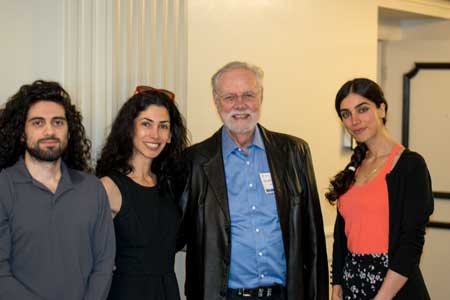
Ron Davis, Fereshtah and her Iranian team. The size of the study Fereshtah is leading was a revelation.
The team is finding evidence of overwhelming activation of the immune system and a counter-veiling anti-inflammatory response that may be reminiscent of what’s happening in autism. Some of the strongest signals suggesing that glycogen storage is affected are showing up as well.
Their genetic data on familial and sporadic cases of ME/CFS shows an enrichment in mutations affecting genes and pathways involved in immune system and metabolism in ME/CFS patients, with some patients having multiple mutations affecting the same gene or pathway (that might explain the severity of the disease and wide range of symptoms).
The data also suggests a potential connection between Ehlers Danlos Syndrome (EDS) and ME/CFS. (Snyder noted the strong symptomatic overlap between EDS and ME/CFS.)
This, of course, isn’t the first time EDS has been mentioned in the same breath as ME/CFS. Alan Pocinki feels EDS is substantially underdiagnosed in ME/CFS, and a recent hypothesis paper puts ME/CFS and EDS in the same spectrum of disorders.
I asked Fereshteh Jahanbani, the leader of the Mutli-Omics project in the Synder lab, about the findings. Heterogeneity was a key word throughout the Working Group sessions and Fereshteh is finding heterogeneity in her family studies as well. That’s not necessarily a bad thing. Jahanbani noted that different genetic variants might be leading to the same endpoints – a dysregulated immune system and metabolic impairment that popped up after some severe stressor, such as an infection.
She referenced how an infection appeared to flip a switch in one person which exposed a mutation in a gene which had been inactive before, which then resulted in that person coming down with Type II diabetes.
That’s a pretty apt model for ME/CFS and is exactly the kind of hypothesis they’re probably hoping to uncover; an infection or event that flips some sort of switch, which then turns on an inactive gene mutation or some other factor, which then results in ME/CFS.
Fereshteh noted that most complex diseases are very heterogeneous and pointed out a family in which one gene mutation manifested as full-blown EDS in one person, problems with muscle twitching in another, and severe gum disease in another.
Rigorous Group!
I was eager to get in that big study and was due to give blood the next day during lunch. As we were going to the lab, I mentioned how spacey I was because I hadn’t eaten anything that day. With that, back to the Working Group lunch we went; the protocol, I learned, was not to eat nothing that morning; it was to have breakfast and then eat nothing. Missing breakfast was too much of a change – they wanted as much uniformity as possible in their patients.
Fereshteh mentioned that research wouldn’t be possible without the unconditional support of the ME/CFS community and all the patients and their family members.
The breadth and depth of the Snyder ME/CFS “omics” plus study was indeed a revelation. This, type of study, of course, is exactly what we need – big studies lead by prominent and well regarded researchers.
Alan Light
Alan and his wife, Kathleen Light, have done groundbreaking work on fatigue production in ME/CFS. His earlier studies showed dramatic (highly dramatic!) increases in the levels of receptors that pick up signs of muscle damage. The rather stupendous overreaction Light found suggested that people with ME/CFS may have a fatigue sensitization process going that’s every bit as strong as the pain sensitization problem found in fibromyalgia.
Light, like others, believes that autoimmunity plays a major role in at least a significant subset of ME/CFS patients. He’s found strong indication of an autoimmune response to beta-adrenergic or muscarinic receptors in ME/CFS. Almost all the ME/CFS patients in a small study (15/18) had autoantibodies to receptors (muscarinic/adrenergic) that control blood flow. With autoimmune findings beginning to show up in POTS, it’s getting hard to believe that something like this is not happening to the blood vessels. Time, of course, will tell.
The Lights believe that a process called molecular mimicry may be causing an autoimmune response in ME/CFS. Molecular mimicry occurs when the immune system mounts a response to a pathogen which ends up targeting human tissues as well.
Here’s where it gets tricky, though. Light’s recent data suggests that multiple mitochondrial and chromosomal mutations, which whack the energy levels of immune cells, are triggering an autoimmune response. Light asserted that immune cells deprived of energy are going to mess up at some point and start attacking human tissues. That idea intuitively makes sense, but Dr. Hanson’s earlier study, which used a more rigorous approach, found no evidence of mitochondrial mutations at all.
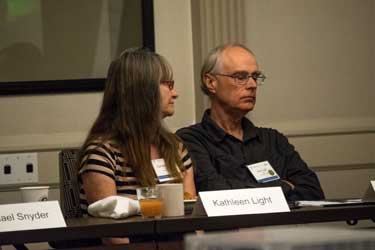
The Lights are hoping that some doctors will produce case reports on their experiences with Rapamycin in their ME/CFS patients.
Light’s presentation was met with a stream of questions. Dr. Naviaux noted that his findings were not controlled for pseudo-genes, and that DNA sequences (which Dr. Hanson used in her study) – not the RNA sequences Dr. Light used – were the best test. Dr. Light stood his ground, stating that the suggested tests were underway. We’ll have to wait to see whether Dr. Light’s intriguing preliminary findings will be validated.
Taking advantage of the superlative genetic resources available to him in Utah, Light is also studying families with ME/CFS, and has found a greater incidence of guess what – autoimmune diseases – than expected. He’s also finding a much higher incidence of migraine. He’s not the first to find that. Migraine, another “invisible illness” which mostly strikes women, may be vastly understudied in ME/CFS.
Doctor Alert! – During a break Alan and his wife, Kathleen Light, made a plug for rapamycin (rapamune) case reports in ME/CFS. Several accounts of ME/CFS patients doing better on Rapamune have been making the rounds. The Lights dearly want those case studies to get written up in the scientific literature. That’s all they need to provide the foundation they need to get Rapamune studied in ME/CFS.
Alain Moreau
Moreau was something of a surprise. A Canadian fairly new to the field, I’d never heard of him. An engaging figure with a booming voice, Moreau got into this field in an unusual way. While director of research for a hospital, the Sybolla Foundation asked him to do an analysis of research gaps in chronic fatigue syndrome. By the time he finished the analysis, he said he’d fallen in love with the disease and applied for a research grant from the Sybolla Foundation.
Moreau was the researcher behind the now infamous research grant application which was turned down by the Canadian government on the grounds that ME/CFS is not, well, a biological disease. In conversation, Rose said the Canadian government had privately recognized the mistake and is going to redo the grant. If the episode was painful for the ME/CFS community, it did have the benefit of rallying the community together, he said.
Moreau was asked to produce a stress test which produced post-exertional malaise – but didn’t wipe out the patient – like exercise tests do. He settled on a massage machine that’s able to produce PEM symptoms over 90 minutes in about 2/3rds of patients. Moreau is very high on the machine and offered to invite other researchers to become familiar with it.
His (amino acid?) study suggested that the most severely affected patients display a molecular signature that’s high in homocysteine and low in vitamin C.
Discussion
Glycolysis or gluconeogenesis? Poor glucose control is present but how is it happening? Problems transporting glucose into the cells could help explain the fatigue. Dr. McGregor from Australia noted that a glucose tolerance test indicated that 65% of patients had exaggerated but truncated glucose tolerance; that is they reach their peak glucose uptake within 30 minutes but within an hour their glucose uptake was falling fast.
McGregor said that some sort of insulin resistance was going on there which was correlated with fatigue scores.
Mark Davis
As expected Mark Davis’ presentation was a highlight. The immunologist Dr. Montoya worked with on his big cytokine study, Davis talked about that study first. Montoya’s long awaited study – six or seven years in the making, he said – found almost no differences in cytokine levels between ME/CFS patients and healthy controls, but still suggested that many cytokines contributed to severity in ME/CFS.
The difference between the null finding with the controls and the dramatic association between cytokine levels and severity within the ME/CFS group was striking indeed. With no less than a third of the 51 cytokines associated with severity, the results were strong. Those strong findings made it all the more remarkable that the less severely ill and moderate cases of ME/CFS either had normal or lower than normal cytokine levels.
Something unusual is clearly going on with cytokines and ME/CFS – something Mark Davis hadn’t seen before. He suggested that the healthier patients might be able to tamp down a pro-inflammatory process that the sicker patients can’t rein in at all – leaving them exposed to the full force of the pro-inflammatory cytokines. Exhibiting his wry sense of humor, Davis opined that that idea “could be true, might be true and ended up with calling it a ‘definite maybe'”.
Davis saved the best for last. Mark Davis has developed a method to track T-cell clonal expansion in various diseases. T cells “go clonal”; i.e. start producing replicas of themselves in vast numbers when they meet up with an antigen – a protein nipped off a pathogen or toxin by an immune presenting cell – they don’t like. The T-cells produced during this process are like a honing missile; they’re designed for one purpose and one purpose only – to search out and destroy anything that presents with that antigenic signature. High numbers of clonally produced T-cells are a sure sign of significant immune activation.
Davis has found high rates of clonal expansion in several diseases including Lyme disease, and several autoimmune diseases. When he turned to ME/CFS, he found the same signature – T-cells that were popping off clonal cells like there was no tomorrow. Like Lyme disease, the clonal expansion found in ME/CFS involved their cytotoxic or killer T-cells. ME/CFS patients’ killer T-cells were on the attack.
Either an autoimmune process or some sort of foreign antigen; i.e. an infection or toxin, had to be setting those T-cells in ME/CFS on edge. Davis’ findings are preliminary; he’s finding a strong signal, but needs to test more samples. If his findings hold up, the next step is attempting to identify what is tweaking the T-cells in the ME/CFS patients. If Davis can find that out, he may have a shot at discovering what is triggering the disease.
Right now his bet is on an autoimmune process probably initiated by an infection. Everything he sees about the disease says autoimmunity to him right now.
There are several reasons to hope that Ron Davis gets his ME/CFS research center funded: his experience in managing large projects successfully, the remarkable growth of his team, the prominent scientific advisors he’s gathered, plus, of course, the nano-needle research and the hunt for the mysterious factor in the blood that appears to be whacking ME/CFS patients’ cells. Another very good reason is Mark Davis’ new findings; included in the research center proposal is a nice fat grant to extend Mark Davis’ work.
During the discussion period following Mark Davis’s talk, the other Davis – Ron Davis – who loves to ask probing questions, asked Mark Davis to tell him why the cytokines are not an “artifact” of this disease. Why aren’t cytokines just noise that’s distracting us from the real problems in ME/CFS, Davis asked.
The other Davis admitted that it wasn’t clear if the cytokines were correlations or if they were causal but argued that the data he has from 1,000 healthy people suggests that something is really off in the immune systems of chronic fatigue syndrome patients.
Naviaux has a way of turning things on their head sometimes. He seems to look at things from angles that others don’t think of. He also agreed that finding T-cells stimulated in ME/CFS suggests a problem is there, but noted that another big problem in ME/CFS could be things that aren’t being activated. Ron Davis earlier noted that the factor in the plasma that’s whacking ME/CFS patients cells might be something that’s missing.
Naviaux couldn’t stress enough how important it was to stress ME/CFS patients’ systems and see what happens. Only then could you identify what’s being produced and not being produced in this disease.
Jarred Younger
It was good seeing Jarred Younger at the Working Group session. He doesn’t have the resume of some of the other researchers, but he’s smart, he’s young and he’s been able to get NIH grants. He’s the wave of the future and it was good to see Davis include him.
Younger’s presentation, I thought, hit all the right notes. Younger simply presented his early good day/bad day research study results, elucidated some of his early findings, and then asked for suggestions how to improve the study or who might be able to use his valuable samples.
Younger is doing a “longitudinal study”; that is, he’s tracking patient symptoms and blood results over 25 days. Thus far, he’s found that C-reactive protein – a marker of inflammation that could be associated with pathogens – is popping out in about 30% of patients. Similar to what Montoya and Davis found, the CRP levels Younger’s finding are not high relative to the controls, but they are highly correlated with fatigue severity.
Fractalkine, which is often elevated in inflammation, and which suggests microglial involvement, is popping out in another 30% of patients. Fractalkine is another mysterious substance. The fact that it’s popping up in Younger’s study means something is up – probably with the microglial – but Younger can’t tell if increased fractalkine levels are a good thing or a bad thing.
Discussion
Raeka, the moderator, expertly peppered the group with questions at times during the discussion periods. One was: what data is missing that we really need? Proteomics; i.e. the proteins in the bloodstream – one of the more difficult substances to measure, is definitely missing. Very few proteomics studies have been done in ME/CFS.
More longitudinal data was another need. Michael Snyder stated that people underestimate just how much you can learn from longitudinal studies. We have a couple of longitudinal studies going (Younger’s Good Day/Bad Day) and Lipkin’s year-long monitoring study (which apparently has samples, but no money yet to test them). These longitudinal studies are so important because more or less frequent sampling allows researchers to get a true baseline. You can really filter out the artifacts from the real stuff using these studies.
Neil McGregor
Neil stood up and said, “I got dragged into ME/CFS. All these patients kept walking into my office.” That was back in 1991. Dr. McGregor got dragged in pretty good. He co-edited the Journal of Chronic Fatigue Syndrome and pioneered the use of metabolomics in the disease. Now here he is conferring with some of the top minds in the field. I have the feeling that he felt it was long past time that that happened. 🙂
McGregor noted that ME/CFS looks like very much like a heterogeneous disease. If you want homogeneity in ME/CFS you’ve probably got to go to an outbreak which was triggered by one factor. (McGregor seems to agree with Fereshtah that there are different ways – depending on the environment insult and a person’s genetics – to arrive at ME/CFS).
Still the symptoms found in ME/CFS can be clustered, and and once they are, can be associated with distinct biochemical processes. A regression model suggested that one factor – glycolysis – was the best determinator of fatigue, while widespread pain, on the other hand, was best predicted by electrolyte and amino acid losses. Mood changes were most associated with increased glucose levels and reduced tryptophan levels.
Dr. McGregor, Dr. John Whiting and one other person, whose name escapes me, have been working for several years on a large gene polymorphism study. The mutations that popped out in the ME/CFS group were intriguing indeed. A factor analysis illuminated seven factors, three of which revolved around one enzyme – GTPase – which is involved in sensory perception and other matters. (If McGregor and Whiting’s findings are correct, they may have uncovered the first link ever to the sensory problems that dog so many people with ME/CFS.)
Other mutations involved viral DNA removal, orthostatic hypotension (sympathetic and parasympathetic nervous system functioning) and pathogen recognition/binding genes.
That’s a pretty sweet list of factors given what appears to be going on in ME/CFS. The most surprising thing, though, was how abundant some of them were. Some of the mutations were from 3 to 12 to even 25-fold more likely to occur in ME/CFS patients. Later, talking at dinner, McGregor gave a series of fist pumps as he stated that when he saw those numbers he knew he was really onto something. Let’s hope he’s right.
Maureen Hanson
In her former life, a highly respected plant biologist, Maureen Hanson has a son with the disease. Despite cutting her teeth in a very different field, Hanson has managed to garner several NIH grants and is engaged in a wide variety of topics including exercise, metabolomics, genetics and the microbiome. Hanson has gone so far as to create an ME/CFS Center at Cornell and apply for a Research Centers Grant. She’s also on the Scientific Board of Advisors for the Simmaron Research Foundation. An impressive figure, she didn’t talk that much during the Working Group, but when she did, she exuded competence.
Gut Study
Hanson is busy, busy. She’s collaborating with a Norwegian group to assess the effectiveness of fecal transplants. She noted that a former study found evidence of increased lipopolysaccharides (LPS) – a bacterial toxin. If I got it right, Hanson’s going to assess ME/CFS patients’ microbiomes and the levels of an LPS detecting protein, before and after fecal transplants.
Besides CBT and GET (which are more management than treatment studies), ME/CFS treatment studies are rare. Hanson wryly noted that the fecal transplant study, like Rituximab, was coming from outside the U.S. (The U.S. government’s unwillingness to fund any ME/CFS clinical trials is why CBT/GET trials dominate the treatment literature; the U.K. and the Netherlands have been happy to fund many, very large and expensive CBT/GET trials.)
Metabolic Issues
Hanson’s latest project is a fascinating one as well. A “little” frustration crept through when she said that this study was ACTUALLY funded by the NIH (lol). Hanson used the Seahorse machine to assess the energy production of T-cells. The Seahorse machine – the latest innovation in measuring cellular energy production – is getting around; Ron Davis, Isabel Barao, Maureen Hanson and others have used it.
T-cells are a good subject, because in order to spring into action to kill other cells or to produce clones of themselves to fight invaders, it takes enormous amounts of energy. If energy production is flawed in ME/CFS it’s probably going to show up in their immune cells.
Hanson didn’t find impaired glycolysis; when glucose was given to the immune cells they were able to use it, but their respiratory capacity (oxidative phosphorylation) was blunted. That suggested that the immune cells of ME/CFS patients were less able to produce energy using oxygen, and therefore, perhaps less likely to become activated.
That seems, to this layman anyway, to make perfect sense given the low aerobic functioning found in ME/CFS. Those low V02 max results found in many ME/CFS patients indicate the aerobic energy production system punks out early – so why not the immune system as well?
The Solve ME/CFS Initiative (SMCI) is funding a suite of studies examining the energy levels of immune cells.
In another study which the SMCI helped to fund, Hanson’s Metabolon metabolomics study found lower glucose levels (again a surprise) but differences in fat and lipid metabolism (i.e. energy production) and in the sphingolipids that play a big role in Naviaux’s findings.
Hanson noted that low glucose is not so good either. In fact, athletes with higher glucose levels do better in endurance sports than patients with lower glucose levels possibly because of less inflammation. Overall, Hanson’s metabolite findings suggested increased inflammation and reduced recovery from metabolic stress.
The Newcomer – Robert Phair, PhD
Robert Phair didn’t present but was a vocal participant in the working group sessions. The Chief Science Officer at Integrative Bioinformatics, Inc., Phair is a systems biologist.
Phair’s story indicates why it’s important that we keep communicating, communicating, communicating about this disease. Phair had a friend with the disease, but didn’t know diddly about it or what he could contribute towards it until a piece on ME/CFS appeared in the Stanford alumni magazine.
He said “Without that story, I wouldn’t be here.” He contacted Laurel Crosby and has been volunteering with her and Ron about one day a week for the past year. He contributed many insights during the Working Group discussion. He consults on Davis’ ME/CFS research projects, and assists with overall strategy, experimental design, and data interpretation.
Jonas Bergquist
Bergquist was a co-author of a large cerebral spinal fluid proteome study contrasting ME/CFS and post-treatment Lyme disease patients.
Bergquist has continued his ME/CFS work in the blood and spinal fluid. Early results with a German group suggest 20-30% of ME/CFS patients have auto-antibodies to the adrenergic and muscarinic receptors that affect blood vessel functioning.
Berquist noted that finding something in the blood is encouraging given that it’s so much easier to access than the cerebral spinal fluid. Preliminary results from a metabolomics and cerebral spinal fluid study are looking good as well. (Stay tuned for results from the Simmaron Research Foundation’s metabolomics and cerebral spinal fluid study…)
Bob Naviaux
Naviaux gave the keynote speech for the Symposium and was an active participant – asking many questions and offering many suggestions – during the Working Group session. His grasp of many different fields is impressive indeed.
Naviaux’s metabolic studies suggest that people with a dozen different diseases, ranging from autism to Gulf War Syndrome to PTSD to mitochondrial diseases and, of course, ME/CFS, are trapped in a cellular defense activation which serves to shut down energy production in their cells. Naviaux emphasized that in ME/CFS and these other diseases, it’s not about the trigger, but in resolving the response to cellular stress.
Stating one of his Zen comments, “you’re chronically ill, because you can’t get better”, Naviaux stated that he believes that healing in ME/CFS is being blocked at specific control checkpoints in a cell. The idea that specific cellular control checkpoints – that may be blocking a return to health – have been identified, was good news indeed.
The cell danger response that Naviaux believes people with ME/CFS are trapped in results in reduced mitochondrial consumption, reduced intracellular oxygen, increased free radical levels, increased release of ATP from the cell, and activation of endogenous retroviruses. Once out of the cell, ATP warns other cells that there’s danger in the area; to survive it, the cells shut down.
Naviaux contrasted the 25% of metabolites that are common to chronic fatigue syndrome (ME/CFS) with the 75% that were specific to individuals. He followed that up by noting that half of the metabolites associated with ME/CFS were different between men and women. That’s sounds like a pretty heterogenous scenario, but Naviaux believes there is a common core to ME/CFS.
Naviaux looked through 2,000 drugs to find one which had the kind of anti-purinergic effects he was looking for, called Suramin. The drug did very well in a small proof-of-concept trial in autism. The one-dose trial found that every autistic child demonstrated significant and unusual improvements in speech and/or behavior. Suramin is not a perfect drug – it doesn’t do everything Naviaux would like – but Ron Davis noted that it does appear to return ME/CFS cells to a more normal state. (A blog on the Autism trial is coming up.)
With regards to treating chronic fatigue syndrome, Naviaux said the first step was to remove the trigger (infection, toxin, etc.) if it’s still present, then to use metabolomics to identify the metabolic gaps that need to be addressed in order refill the person’s metabolic “tank”, and then to use anti-purinergic drugs such as low-dose Suramin to turn off the cell danger response. If I got it right, the approach is both personalized and broad-based; Suriman turns off the cell danger response and then metabolomics results guide the treatment approach from there.
Editorial
The results of the Bergquist Lyme/ME/CFS spinal fluid study were fascinating: it found different protein signatures in the spinal fluid of people who’ve been treated for Lyme disease and ME/CFS. That suggests that these two diseases or conditions, which look so similar and which some people think are the same, are probably quite different; pTLD is not a subset of ME/CFS or vice versa.
This undoubtedly quite expensive study seemed to portend a bright future. The paper was downloaded 37,000 times. The authors believed that their new “proteomic strategy” portended a bright future. They believed it would “accelerate the transition from a discovery phase of candidate biomarkers, as described in this study, to full validation for clinical application”. They also believed that “Distinguishing CFS and nPTLS (would) have etiologic implications which could lead to novel diagnostics and therapeutic interventions”; i.e. they believed we were on the track to getting biomarkers and using them to develop novel treatments.
You can probably guess the results. Despite the striking findings, six years later, biomarkers have not been established and clinical applications based on this approach are nowhere to be seen. In fact, this group has not published another paper on ME/CFS.
Now picture a different approach to this disease, an organized approach such as Ron Davis has suggested. In that scenario, you do your big OMIC’s and other studies, and then build on your findings. If you do a study which suggests a distinct protein signature may be present, you take the next step. That is all too rare in intermittently funded ME/CFS.
If we had an organized, adequately funded approach to this disease, that next step would have been taken and years not lost, as they were in this case.
Ron Davis and Ian Lipkin have suggested that $5-10 million a year would be enough. That’s a lot of money for an individual or a couple of individuals to give, but I think there must be donors out there who want to go all in, who recognize that there is just no substitute for a well-funded and organized approach to this illness. The difference between a million dollars a year and 5 or 10 million dollars is the difference between an effort that makes progress but slowly, and one that can take on this disease and make a real difference.
Let’s have no more big studies that get lost. Let’s produce an effort which uses the best technologies and the best researchers and which funds nice big studies that get into nice big journals which make nice big headlines. Let’s work together as well. Let’s decide on what should go into a study, which kinds of platforms to use, which kinds of tests to run – and stop producing studies that don’t relate to each other and that other researchers can’t build on.



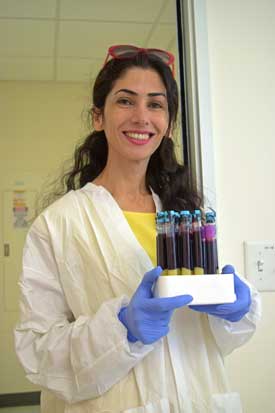
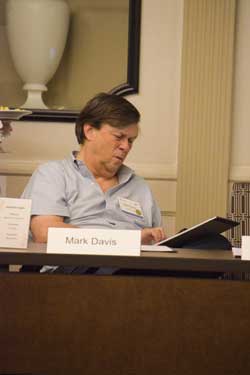
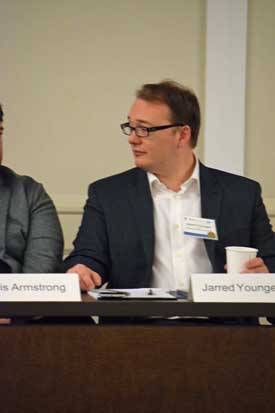







What about researching the effect of Epstein bar virus on the immune system and it’s relationship with cfs/ME?
Some researchers are doing that but its slow. There’s a German group, there’s a researcher in Ohio, I think it is, the SMCI may be funding a study….I
Thanks, you are a terrific communicator of this stuff. Much appreciated
I agree with Anne excellent article.
Cort check out Jonas Bergquist’s presentation at the Invest in ME Research International ME Conference 2015. From memory he suggested that the protein data indicated that some of those with ME/CFS had a glycoprotein disorder.
Here Neil McGregor is suggesting that the genetic data indicates that they have a higher incidence of mutations on the gene which codes for the G-protein coupled receptor protein.
Any thoughts regarding a possible link between Bergquist’s data and McGregors?
Thank you, this an incredible report, I wish I understood half of it, but so heartening to know that so many researchers are sharing their findings. 🙂
Thanks Cort, you always explain these things so well.Exciting times.
Thank you Cort for your excellent update! I hope they will find something soon. We are waiting so long now.
Thank you, Cort, for your excellent summary of the research presented at the Working Group sessions. So nice to see quality researchers from different institutions and approaches collaborating. It is especially important that the researchers could receive critical feedback on where their thought processes might need redirection.
Also, it was a pleasure to meet you in person at the Community Symposium (I certainly don’t expect you to remember meeting me… ?).
Cort you deserve a long rest, amazingly well done job. I will now go back with a pencil and take notes. The serotonin connection is very interesting as I’ve recently been thinking about my own issues and serotonin.
Thank you Cort! What a tremendous amount of information! You doan amazing job of relaying these events to us…greatly appreciated!
If I were looking for major funding I think I’d be promoting the ‘organized, adequately funded approach’ as a prototype for research into all diseases. Medical research generally is pathetically nibbling and disparate. There must be plenty of wealthy people suffering from other intractable diseases that really need this approach.
Well done, Cort, thank you for your incredible persistence and insight!
Thank you, Cort for the thorough review, It will take me days to get through all of it, but so grateful for your hard work getting this out to the CFS community!
There is a very simple model of CFS which have 2 parts. The first part is the elimination of lactobacillus, bifidobacteria and E. Coli in the guts of patients (first reported in 1998 in Australian Study). When they disappear, a ton of other items stop being produced.
If you look at what they produce AND look at supplements that help CFS — you find an awesome match up. See this post from today
https://cfsremission.com/2017/09/09/theoretical-supplements-for-cfs-etc/
How about identifying the various items that cause improvement (e.g. glutamine, hydrocortisone acetate, etc.) and trace back (via processing pathways) to diagnose what’s going on, similar to debugging a program, and see where the dysfunction occurs? There ARE things that give some relief and focusing on how & what type of improvement they provide would be a more targeted approach (& hopefully more effective) as opposed to throwing everything up on the wall and seeing what sticks. Perhaps then we can discern why EBV causes CFS in many people.
With Dr. Montoya and Mr. Xiao finding that ME/CFS correlates directly to SIRS, I’m wondering if any CFS patients have tried the Marik protocol? Dr. Marik is a professor of medicine who has presumably found a cure for sepsis. Why do I bring up sepsis? Here is its definition: “Sepsis is the systemic response to infection and is defined as the presence of SIRS in addition to a documented or presumed infection.”
Here’s where I’m going with this – could we have low level infections, parasites, fungus etc. that are keeping our bodies in a state of SIRS? Could we try reduced dosages of Dr. Marik’s Sepsis protocol? Here’s a link and on that web page to the right, is his protocol. http://www.evms.edu/about_evms/administrative_offices/marketing_communications/publications/issue_9_4/has-sepsis-met-its-match.php.
Also keep in mind that Mr. Xiao found correlations between ME/CFS and parasites, gram-negative bacteria, trypanosomatidae, and a couple other things. If you want to see this for yourself, go to the link below, go to the 6:41:36 mark. https://www.youtube.com/watch?v=s7bBMXQSmuM&list=PLl4AfLZNZEQPZoKHWCdepq64jtN2SvW5d
Very interested in this as well. I wonder if Dr Marik would be willing to do a small trial
Cort you are so clear and descriptive with your writing and I appreciate your your reporting! We are fortunate that you were sitting in on the symposium meeting and able to give us the “lowdown”. My 26 year old son is just about bed bound with this awful disease and this gives me such hope and encouragement on finding a solution.
Thank you
Ann P
Great review Cort!
Interesting that I am now being treated for CIRS and Lyme, and what once was thought to be a protozoa (Protomyxzoa Rehumatica) is now thought to be a mold/fungus. There is definitely autoimmune issues and inflammation. Not to mention – POTS, EDS and MCAS. All of which plays a part.
My sister and I are in the family study of Dr’s Light. She has really bad CFS and when her twin boys turn 18 – they will be included. My sister and one of her boys both have CIRS and MARCONS – as do I. We are getting more puzzle pieces. We are genetically predisposed to be unable to throw these things off. And we are resistant to antibiotics that could potentially help us fight these things. I think for us – this will be a lifelong fight.
Issie
Issie, I remember a while back you were talking about Dr. Fry. Do you know if he has made any progress in finding a protein that will combat the mold? Puzzle pieces indeed!
I haven’t heard if he is ready to release the info yet. He told me earlier that he knows what the genetic defect is and believes he knows what protein we need. But, doing the research and getting something approved by Big Pharm may take awhile. He is hoping to have a way for us to get it either injection, oral – he wasnt sure then. He has a lot of other scientist working with him. He is no longer seeing patients and is dedicating all his time to trying to get us a solution. He is in the lab and research exclusively.
I’m seeing a new doc who is a Shoemaker and Klinghardt trained doc. She did all the testing for CIRS and MARCONS. She is also treating me for Lyme and Babesia. Interesting that one of the antibiotics used for these – I’m resistant to. No wonder I wasn’t having herxing and no noticeable response to it. We are doing it with herbs this time around. Having to go really slow. Having a time with taking the binders. Those with EDS, it appears, has more issues with binders.
Issie
Are they like blind men touching an elephant? Hope someday they would piece together a complete picture.
– Comment from a frustrated patient.
Thanks for your always excellent explanations. The video of the symposium is available on youtube, and I’ve been looking for timestamps for each talk since 8 hours of video is too much of course for most of us to watch. Do you happen to have that information?
Its available on Phoenix Rising.
Thanks!
After more that forty years with this disease it is so very gratifying to see so many very great minds dedicating themselves to figuring it out and finding a cure. Thanks Cort for such a wonderful overview of this work.
Small question: You said somewhere above: “A Simmaron Research Foundation study found distinctly different spinal fluid signatures in the atypical (more severely ill, often unusual disease onsets, increased comorbidities) vs the more typical patients.”
I was under the impression that at least some were defining “typical” simply as those with ‘sudden onset’ from viral infections mainly. And “atypical” was what’s been called ‘gradual onset’ (as in my case which appeared to be from a series of events, much like Whitney Dafoe’s was also). Can you add any more clarification to the definition of this?
One reason I ask is because, as I understand, the NIH big study is using only ‘typical’ post sudden viral cases. Yet in the 40 yrs I’ve had the disease I was not aware, until fairly recently, of people with ‘sudden onset’ and worry about research using only ‘typical’ sudden onset and not including the rest of us (who may be more numerous).
Actually, in my recollection atypical is more like – people who got sick outside the country, or had a blood transfusion or developed a strange comorbidity (like Corinne with her spinal lesion) or even, I think, people who are just really, really, really sick.
I had gradual onset so I share your concern! I guess they had to start somewhere and this was the best place to start particularly given Avindra Nath’s experience (post infectious neurological diseases)
Cort,
Thank you for the excellent write-up. It is great to hear what the researchers were thinking about at the Symposium. Please keep this information coming…
It gives us hope and there may be ways we can use it, not only to help ourselves, but to work as advocates to gain more visibility and funding for this vexing disease.
Thank you thank you thank you Cort?
I listened to the webinar version but was really waiting for your write up including the working group sessions. And the ‘Dr. Alert’ from the Lights about Rapamune was incredibly encouraging. So very well done. You deserve a rest now. You carry so much of the heavy lifting of dissecting all this amazing material and it is appreciated.
Hi Cort
As someone who watched the presentations online thanks for a fantastic writeup…
I have 3 questions:
Can you tell us the gene that Davis has found to be mutated in severely ill?
I am fascinated to hear that Montoya is not part of the group given he is ‘a few buildings away’… What’s yourb understanding on why this is-surely he would be a great addition
As someone who has tested positive to lyme but whose symptomolgy is severe ME/CFS and a reported positive to ME/CFS genes by my doctor Dr Whiting I was interested to read the Berquist distinction findings between Lyme and ME/CFS… can you provide a link to that study?
Cheers
Anthony
Don’t know what gene it is. I know it affects serotonin….which could mean alot – Mady Hornig told me serotonin affects many different things in the body
With regard to Montoya and Davis – both submitted applications for a research center so there is some healthy competition going on there. As to why Montoya didn’t attend I don’t know.
https://www.sciencedaily.com/releases/2011/02/110223171235.htm
The NIH RFA for Collaborative Centers were not enough money to fund all the research Stanford people wanted to do, so Montoya decided to submit his own grant. Really, it’s not a lot of money.
Cort, you are such a gift to us!
Fantastic write-up, thank you Cort!
The key question is: with all these great researchers trying to solve the mystery of ME/CFS, how soon is an effective treatment likely to be available?
Are we talking months? Years? Decades?
Here’s the quickest path that I can see: Ron Davis identifies either what is blocking the energy in our cells or what in the plasma is missing that the cells need. To do that he needs to do more work on the nanoneedle -prove that its doing what it appears to be doing – measuring energy fluxes – do a lot more testing in ME/CFS and then find ways to abort that factor or add something to the cell. That just takes money and I imagine, if everything went right (it usually doesn’t in biology) and he had the money it wouldn’t take that long…a year or two maybe, maybe (???)
Thanks Cort; it’s helpful (and inspiring!) to imagine this best-case scenario.
But to your point about everything usually not going right, I guess 3-5 years is more realistic. 🙁
Thanks for the very helpful write-up, Cort.
Thanks Janelle
Thanks Cort for a great report!
Did you hear any news, or anything, from De Meirleir or Lombardi during the seminar?
I saw them both there and talked briefly with Vince. I met with him about a month earlier. I’m really impressed with what he is doing. Just haven’t been able to get a blog out on that.
Looking forward to that blog. Thanks again.
Thanks Cort for the great write up. Your skilled writing helps the field progress forward in its own way! As doctor Robert Phair said: this field needs communication, communication and communication. That you excel at. As many commentators said, you now deserve a good rest after doing such good job!
Thanks also for all these great researchers taking up the glove. It ain’t no easy job. I hope Ron Davis gets rewarded for his relentless efforts by seeing his son improve during his lifetime. That’d be good for both them and us.
Thanks- really appreciate it 🙂
Very good read!! I enjoyed reading the workings of the minds going on in this gathering. Funny, I have migraines, I have symptoms that feel like hypoglycemia, yet my blood sugar is normal. Also the EDS is very interesting as well since that came up many times in my symptom search, though I’m no classic case, all of my joints pop and my knees constantly feel as though they are going to ‘fall off’, yet my hands have no flexibility. Often I find my doctors commenting on how flexible my legs are though as I’m always sitting with my legs pulled up or in a ‘criss cross apple sauce’ kind of way. It’s the only comfortable position for me. I do hope they figure this out. I think for sure, genes and toxins are involved. Not just infections but also vaccine triggers for those who are sensitive. My issues started after vaccinations. I also have a lot of metabolic mutations in my CYP genes. One that is significantly rare as a double mutation and is why I can’t take anti-inflammatory or blood thinning drugs. CYP2C9. Interesting stuff!!
Interesting! Have you been checked out for Ehlers Danlos Syndrome? Sitting with legs pulled up is also a way to get more blood to your heart. Do you have POTS?
I’m confused about your assessment of the Stanford cytokine study here. You wrote they “found almost no differences in cytokine levels between ME/CFS patients and healthy controls.” But I just read the paper and in the abstract they write “Seventeen cytokines had a statistically significant upward linear trend that correlated with ME/CFS severity… Of the 17 cytokines that correlated with severity, 13 are proinflammatory, likely contributing to many of the symptoms experienced by patients and establishing a strong immune system component of the disease”
These cytokines are very high in my case as well, including TNF-a, IFNy, and IL-17.
Are we reading the same study? Am I missing something?
Thanks Cort,
Lucien
The cytokines of severe patients were higher than healthy patients (but not significantly).
cytokines of mild patients were lower than healthy patients (but not significantly).
cytokines of moderate patients were about the same as healthy patients.
What was significant was that this linear association between levels and severity kept showing up, in 17 different cytokines.
tbh I’m not sure how you measure the significance of a trend like that. But when you look at the 51 cytokines, the upward trend in the 17 with this linear association is clear as day.
http://www.pnas.org/content/114/34/E7150/F2.expansion.html
One explanation might be that there is an effect: cytokine increase, and a counter effect: cytokine decrease, and the latter is not strong enough in severe patients.
Ahhhh okay now I see. Thank you Murp that was really helpful!
I’m trying to figure out the study that was mentioned about Lyme and / cfs/me being completely different. Why would contracting Lyme disease be any different of a trigger than any other traumatic event or illness that could potentially trigger cfs/me? Are the results essentially the same? I don’t see how a different protein in spinal fluid matters so much as the end result and its similarity to other triggers?
It could be that all the different triggers end up in the same or very similar symptomatic state but cause it in different ways. It also possible that people with chronic lyme disease are infected with another pathogen that the Tick carried=. Dr Know believes the tick may have passed them Powassan virus; the treatment got rid of the Lyme but they still have another infection.
So interesting. After 40 plus years (me too Liz)! I was in the very severe range, with migraines that would last 3 weeks and a blood sugar dangerously low. Unable to walk from bed to bathroom. And the sore throats! (I have one now – it lasts for weeks). I totally lost 7 years of life in the 1980’s when we were written off as psychotic. Still battling now. I was diagnosed by Prof John Dwyer, immunologist, in Sydney, Australia, who went by T cell counts and skin immune reactions. Things that have helped me – Kefir (Turkish probiotic) & Astaxanthin (a natural anti-inflamatory).
I am becoming more and more convinced of autoimmunity in CFS.
For example, many autoimmune diseases have fatigue as a key symptom, and like CFS many autoimmune diseases have natural killer cell dysfunction.
Related to my comment above, I’m very interested to know if anyone’s CFS started after being on accutane (isotretinoin) treatment for acne. There are indications this drug can potentially contribute to triggering autoimmune conditions. My CFS started at the back end of an accutane treatment.
Hi Matthias, mine started after taking tetracyline for acne.
Which leads me to wonder if the acne was an early sign of an existing immune problem, and the tetracycline (or, in your case, the Accutane) merely pushed it over the edge, so to speak.
Accutane triggered long lasting depression in a friend. It’s a horrendous drug.
Re observation that something in the blood is affecting cell metabolism i.e. a large molecular possibly a protein (antibody). On the face of it you could add the relevant weight fraction of the patients plasma to healthy plasma and test the cell metabolism. Eventually you may find the correct size/weight band and test that using mass spectrometry to find the proteins present. Probably really difficult to find low levels of an protein (antibody).
Lots of good stuff here; any idea when we’ll see some of it published. E.g. the identity of the gene that’s turned up in most severely affected patients or whether the auto antibodies (identified by Light, Bergquist) are causal etc?
Can you say more about pain and it’s role in ME/CFS?
I think it plays a huge role for many people (including me). While some people don’t experience it, it’s one of the most commonly named symptoms in ME/CFS.
Under the section on Alain Moreau, you’ve written,
“In conversation, Rose said the Canadian government had privately recognized the mistake and is going to redo the grant.”
Who is ‘Rose’ in this article Cort? I don’t see another reference to this person.
Thanks Cort.
Whoops! It should have been Alain. Thanks for pointing that out.
Thanks for the clarification Cort.